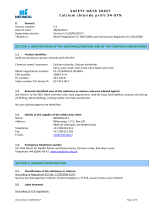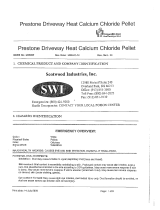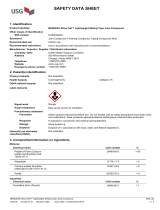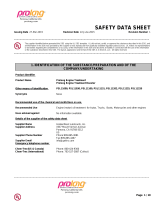
Roofmelt Safety Data Sheet
Material Name: Roofmelt SDS DATE: 06/01/15
*** Section 1-Chemical Product and Company Identification ***
Company Identification : Kassouni Manufacturing, Inc. Emergency Contact: 1-866-588-7088
815 South Front Street
Belding, Michigan 48809 Information Number: 1-616-794-0989
Product Identification: Roofmelt Ice Dam melting Tablets
*** Section 2-Hazards Identification ***
Identity: Calcium Chloride, Dehydrate Cas#: 10043-52-4 %: 100
Emergency Overview:
Color: White
Physical State: Solid
Appearance: Tablets
Odor: Odorless
MAJOR HEALTH HAZARDS: Causes Eye and Skin Irritation. Harmful if Swallowed.
PHYSICAL HAZARDS: Heat is generated when mixed with water or aqueous acid solutions.
PRECAUTIONARY STATEMENTS: Wash thoroughly after handling.
*** Section 3 – Composition/Information on Ingredients
CAS #: 10043-52-4
Component : Calcium Chloride
Percent: 100
*** Section 4 - First Aid Measures ***
First Aid: Eyes
Remove contact lenses and immediately flush eye with lots of cool running water for at least 15 minutes. If
irritation occurs, seek medical attention.
First Aid: Skin
Wash with plenty of water. If irritation develops seek medical attention.
First Aid: Ingestion
If swallowed, rinse mouth. Call a POISON CENTER or doctor/physician if you feel unwell.
First Aid: Inhalation: If inhalation of dust occurs and adverse effects result, remove to uncontaminated area. Call a
POISON CENTER or doctor/physician if you feel unwell.
*** Section 5 - Fire Fighting Measures ***
General Fire Hazards:
This material does not burn.
Hazardous Combustion Products:
Formed under fire conditions: hydrogen chloride gas, calcium oxide
Extinguishing Media:
Use extinguishing agents appropriate for surrounding fire.

Fire Fighting:
Keep unnecessary people away, isolate hazard area and deny entry. This material does not burn.
Fight fire for other material that is burning. Water should be applied in large quantities as fine spray. Wear NIOSH
approved positive-pressure self-contained breathing apparatus operated in pressure demand mode. Wear
protective fire fighting clothing (includes fire fighting helmet, coat, trousers, boots, and gloves). Avoid contact with
during fire fighting operations. If contact is likely, change to full chemical resistant fire fighting clothing with
self-contained breathing apparatus. If this is not available, wear full chemical resistant clothing with self-contained
breathing apparatus and fight fire from a remote location. For protective equipment in post-fire or non-fire clean-up
situations, refer to the relevant sections.
*** Section 6 - Accidental Release Measures ***
Containment Procedures: Small and large spills: Contain spilled material if possible. Collect in suitable and
properly labeled containers. Flush residue with plenty of water.
*** Section 7 - Handling and Storage
Precautions for Safe Handling:
Heat developed during diluting or dissolving is very high. Use cool water when diluting or dissolving
(temperature less than 80
o
F, 20
o
C) Avoid contact with eyes, skin, and clothing. Do not swallow.
Wash thoroughly after handling.
Safe Storage Conditions:
Store in a dry place. Protect from atmospheric moisture. Keep container tightly closed. Avoid storing in direct light
or heat.
*** Section 8 - Exposure Controls/Personal Protection ***
Threshold Limit Val.:
No TLV established by ACGIH
Effects of over exposure:
Under conditions of prolonged contact or when moisture is present, superficial burns may result. Contact
With abraded skin or cuts can cause severe necrosis. Dust inhalation may irritate nose, throat or lungs. May
Irritate or burn eyes. Ingestion: Low in Toxicity. May irritate gastrointestinal tract.
Eye Protection:
Wear safety glasses with side-shields. For dusty operations or when handling solutions of the
material, wear chemical goggles.
Skin and Body Protection:
Wear clean, body-covering clothing.
Hand Protection:
Use gloves chemically resistant to this material. If hands are cut or scratched, use gloves
chemically resistant to this material even for brief exposures. Examples of preferred glove barrier materials
include: Neoprene, Polyvinyl chloride ("PVC" or "vinyl"), Nitrile/butadiene rubber ("nitrile" or "NBR"). NOTICE: The
selection of a specific glove for a particular application and duration of use in a workplace should also take into
account all relevant workplace factors such as, but not limited to: Other chemicals which may be handled, physical
requirements (cut/puncture protection, dexterity, thermal protection), potential body reactions to glove materials,
as well as the instructions/specifications provided by the glove supplier.
Respiratory Protection:
Respiratory protection should be worn when there is a potential to exceed the exposure
limit requirements or guidelines. If there are no applicable exposure limit requirements or guidelines, wear
respiratory protection when adverse effects, such as respiratory irritation or discomfort have been experienced, or
where indicated by your risk assessment process. In dusty or misty atmospheres, use an approved particulate
respirator. The following should be effective types of air-purifying respirators: High efficiency particulate air (HEPA)
N95. A respiratory protection program that meets 29 CFR 1910.134 must be followed whenever workplace
conditions warrant use of a respirator.

*** Section 9 - Physical and Chemical Properties ***
Physical State: Solid Tablet Form
Color: White
Odor: Odorless
Melting Point: 772
o
C (1,422
o
F)
Specific Gravity: 2.14
Boiling Point: Not applicable
Flammability: Will burn in surrounding fire
***Section 10 – Stability and Reactivity***
Reactivity:
Hygroscopic. Liberates large amounts of heat when dissolving in water or aqueous acids.
Chemical Stability:
Stable at normal temperatures and pressures.
Possibility of Hazardous Reactions:
Avoid moisture.
Conditions to Avoid:
(e.g., static discharge, shock, or vibration) -. None known.
Incompatibilities/ Materials to Avoid:
Avoid contact with: Sulfuric Acid, yields hydrogen chloride gas. Bromide Trifluoride, 2-furan percarboxylic acid
because calcium chloride is incompatible with those substances. Contact with zinc forms flammable hydrogen gas,
which can be explosive. Catalyzes exothermic polymerization of methyl vinyl ether.
Hazardous Decomposition Products:
Formed under fire conditions: hydrogen chloride gas, calcium oxide
Hazardous Polymerization:
Will not occur.
***Section 11 - Toxicological Information***
Oral LD50: 1126 mg/kg – Oral Acute Toxicity Estimate (ATE)
Dermal LD50: 2637 mg/kg – Dermal Acute Toxicity Estimate (ATE)
LC 50 Inhalation: Not determined for product.
POTENTIAL HEALTH EFFECTS:
Eye contact:
For solid: May cause slight eye irritation, mechanical injury only. Dust formation
should be avoided, as dust can cause severe eye irritation with corneal injury.
Skin contact:
Brief contact is essentially nonirritating to skin. Prolonged contact may cause skin
irritation, even a burn. Not classified as corrosive to the skin according to DOT
guidelines. May cause more severe response if skin is damp, abraded (scratched
or cut), or covered by clothing, gloves, or footwear.
Inhalation:
Dust may cause irritation to upper respiratory tract (nose and throat).
Ingestion:
Low toxicity if swallowed. Small amounts swallowed incidentally as a result of
normal handling operations are not likely to cause injury; however, swallowing
larger amounts may cause local mucosal damage to esophagus and stomach.
Swallowing may result in gastrointestinal irritation or ulceration.
***Section 12 - Ecological Information***
ECOTOXICITY DATA:
Aquatic Toxicity:
Material is practically non-toxic to aquatic organisms on an acute basis. (LC50/EC50/EL50/LL50 >100 mg/L in the
most sensitive species tested).
Other Toxicity:
Sodium Chloride: IC50, OECD 209 Test; activated sludge, respiration inhibition: > 1,000 mg/l

FATE AND TRANSPORT:
PERSISTENCE:
Calcium chloride is believed not to persist in the environment because it is readily dissociated
into calcium and chloride ions in water. Calcium chloride released into the environment is thus likely to be
distributed into water in the form of calcium and chloride ions. Calcium ions may remain in soil by binding to soil
particulate or by forming stable salts with other ions. Chloride ions are mobile and eventually drain into surface
water. Both ions originally exist in nature, and their concentrations in surface water will depend on various factors,
such as geological parameters, weathering, and human activities.
BIOCONCENTRATION:
No bioconcentration is expected because of the relatively high water solubility. Potential
for mobility in soil is very high (Koc between 0 and 50). Partitioning from water to n-octanol is not applicable.
BIOACCUMULATIVE POTENTIAL:
Calcium chloride and its dissociated forms (calcium and chloride ions) are
ubiquitous in the environment. Calcium and chloride ions can also be found as constituents in organisms.
Considering its dissociation properties, calcium chloride is not expected to accumulate in living organisms.
MOBILITY IN SOIL:
Calcium chloride is not expected to be absorbed in soil due to its dissociation properties and
high water solubility. It is expected to dissociate into calcium and chloride free ions or it may form stable inorganic
or organic salts with other counter ions, leading to different fates between calcium and chloride ions in soil and
water components. Calcium ions may bind to soil particulate or may form stable inorganic salts with sulfate and
carbonate ions. The chloride ion is mobile in soil and eventually drains into surface water because it is readily
dissolved in water.
***Section 13 - Disposal Considerations***
Waste from material:
Reuse or reprocess, if possible. All disposal practices must be in compliance with all Federal, State/Provincial and
local laws and regulations. Regulations may vary in different locations. Report spills if applicable. Waste
characterizations and compliance with applicable laws are the responsibility solely of the waste generator.
Container Management:
Dispose of container in accordance with applicable local, regional, national, and/or international regulations.
Container rinsate must be disposed of in compliance with applicable regulations.
*** Section 14 - Transportation Information ***
LAND TRANSPORT:
U.S. DOT 49 CFR 172.101:
Status:
Not regulated
CANADIAN TRANSPORTATION OF DANGEROUS GOODS:
Status:
Not regulated
MARITIME TRANSPORT (IMO / IMDG):
Status - IMO / IMDG:
Not regulated
***Section 15 - Regulatory Information***
U.S. Federal Regulations:
Section 313 of Title III of the Superfund Amendments and Reauthorization Act of 1986 (SARA). This product does not contain
any chemicals which are subject to the reporting requirements of the Act and Title 40 of the Code of Federal Regulations, Part
372.
SARA 311/312 Hazard Categories:
Acute Health Hazard:
Yes
Chronic Health Hazard:
No
Fire Hazard:
No
Sudden Release of Pressure Hazard:
No
Reactive Hazard:
No

Clean Water Act:
This product does not contain any substances regulated as pollutants pursuant to the Clean Water Act
(40 CFR 122.21 and 40 CFR 122.42).
CERCLA:
This material, as supplied, does not contain any substances regulated as hazardous substances under
The Comprehensive Environmental Response Compensation and Liability Act (CERCLA) (40 CFR 302)
or the Superfund Amendments and Reauthorization Act (SARA) (40 CFR 355). There may be specific
reporting requirements at the local, regional, or state level pertaining to releases of this material.
U.S. State Regulations:
California Proposition 65:
This product does not contain any Proposition 65 chemicals.
U.S. State Right-to-Know Regulations:
This product does not contain any substances regulated by state right-to-know regulations.
U.S. EPA Label Information:
EPA Pesticide Registration Number:
Not applicable
***Section 16 - Other Information***
Prepared by: Kassouni Manufacturing, Incorporated
Disclaimer:
We recommend that you use this product in a manner consistent with the listed use. If your intended use is not
consistent with the stated use, please contact your sales or technical service representative.
IMPORTANT:
The information presented herein, while not guaranteed, was prepared by technical personnel and is true and
accurate to the best of our knowledge. NO WARRANTY OF MERCHANTABILITY OR OF FITNESS FOR A
PARTICULAR PURPOSE, OR WARRANTY OR GUARANTY OF ANY OTHER KIND, EXPRESSED OR IMPLIED, IS
MADE REGARDING PERFORMANCE, SAFETY, SUITABILITY, STABILITY OR OTHERWISE. This information is
not intended to be all-inclusive as to the manner and conditions of use, handling, storage, disposal and other factors
that may involve other or additional legal, environmental, safety or performance considerations, and Kassouni
Manufacturing, Incorporated assumes no liability whatsoever for the use of or reliance upon this information. While our
technical personnel will be happy to respond to questions, safe handling and use of the product remains the responsibility
of the customer. No suggestions for use are intended as, and nothing herein shall be construed as, a recommendation to
infringe any existing patents or to violate any Federal, State, local or foreign laws.
OSHA Standard 29 CFR 1910.1200 requires that information be provided to employees regarding the hazards of
chemicals by means of a hazard communication program including labeling, safety data sheets, training and access
to written records. We request that you, and it is your legal duty to, make all information in this Safety Data Sheet
available to your employees.
End of Safety Data Sheet
-
 1
1
-
 2
2
-
 3
3
-
 4
4
-
 5
5
Ask a question and I''ll find the answer in the document
Finding information in a document is now easier with AI
Other documents
-
 nedMag NM-CP50BG User guide
nedMag NM-CP50BG User guide
-
 Prestone 95J-HEAT User manual
Prestone 95J-HEAT User manual
-
3M General Respiratory Protection DL DPR Operating instructions
-
DampRid FG01K User guide
-
 BEADEX Brand 385266 FAQ
BEADEX Brand 385266 FAQ
-
Snow Joe MELT40ECO-TL User manual
-
 Prolong Super Lubricants PSL11000 User manual
Prolong Super Lubricants PSL11000 User manual
-
Snow Joe MELT25IB-BKT User manual
-
Lincoln Electric SCPF4POP User manual
-
APC RBC6 User guide








